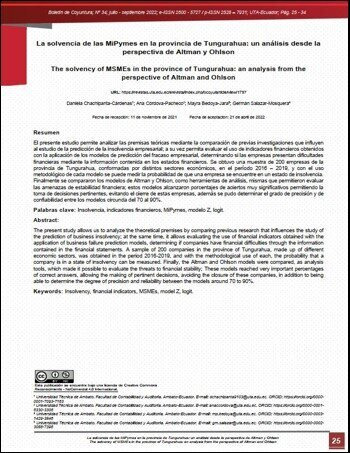The solvency of MSMEs in the province of Tungurahua: an analysis from the perspective of Altman and Ohlson
Main Article Content
Abstract
The present study allows us to analyze the theoretical premises by comparing previous research that influences the study of the prediction of business insolvency; at the same time, it allows evaluating the use of financial indicators obtained with the application of business failure prediction models, determining if companies have financial difficulties through the information contained in the financial statements. A sample of 200 companies in the province of Tungurahua, made up of different economic sectors, was obtained in the period 2016-2019, and with the methodological use of each, the probability that a company is in a state of insolvency can be measured. Finally, the Altman and Ohlson models were compared, as analysis tools, which made it possible to evaluate the threats to financial stability; These models reached very important percentages of correct answers, allowing the making of pertinent decisions, avoiding the closure of these companies, in addition to being able to determine the degree of precision and reliability between the models around 70 to 90%.
URL: https://revistas.uta.edu.ec/erevista/index.php/bcoyu/article/view/1797
Downloads
Article Details

This work is licensed under a Creative Commons Attribution-NonCommercial 4.0 International License.
![]()
The publications of the Boletín de Coyuntura are licensed under a Creative Commons Attribution-NonCommercial 4.0 International License (CC BY-NC 4.0). The Universidad Técnica de Ambato retains the copyright of the published works, and favors and allows the reuse of these, as long as: the authorship and original source of publication is cited, and they are not used for commercial or onerous purposes. The intellectual property of the published articles belongs to the authors.
References
Anzola, O. L., & Puentes, M. C. (2007). Determinantes de las acciones gerenciales en microempresas y empresas pymes. Bogota: Universidad Externado de Colombia.
Beade , Á., Rodríguez, M., & Santos, J. (2017). Modelos conexionistas de predicción de la insolvencia empresarial: Predicción en ambiente real. Universidad de A Coruña e IESIDE, España.
Bolaños, C. (1997). El Fracaso Empresarial y el Contador Público y Auditor como Liquidador de Empresas. Universidad Francisco Marroquin, Facultad de Ciencias Economícas.
Centro de Desarrollo Organización para la Cooperación y el Desarrollo Económicos (OCDE); Comisión Económica para América LAtina y el Caribe (CEPAL). (2013). Perspectivas económicas de América Latina 2013: políticas de Pymes para el Cambio estructural. Cepal, 48-52. Obtenido de Políticas de PYMES para el cambio estructural.
Diaz, L., & Ríos, F. (2018). El valor p. Interpretación, origenes y su utilización actual. Revista Argentina de Terapia Intensiva, 1-4.
Fernández, H., & Pérez , F. (2005). El modelo logístico: Una herramienta estadística para evaluar el riesgo de crédito. Revista Ingenierías Universidad de Medellín, 55-75.
García, J., Sánchez, J., & Tomaseti, E. (2016). Fracaso empresarial y efectos de contagio. Un análisis espacial para España . Red de Revistas Científicas de América Latina, el Caribe, España y Portugal, 429-477.
Gobierno Provincial de Tungurahua. (2020). Agenda Tungurahua 2019-2021. 3.
Hernández, M. (2014). Modelo financiero para la detección de quiebras con el uso de análisis discriminante múltiple. Red de Revistas Científicas de América Latina, el Caribe, España y Portugal, 1-18.
Instituto Nacional de Estadísticas y Censos (INEC). (Octubre de 2019). Directorio de empresas y establecimientos. Obtenido de https://www.ecuadorencifras.gob.ec/documentos/web-inec/Estadisticas_Economicas/DirectorioEmpresas/Directorio_Empresas_2019/Principales_Resultados_DIEE_2019.pdf
Magill, J. H., & Meyer, R. L. (marzo de 2005). Usaid Form the American People. Agencia para el Desarollo Internacional para los Estados Unidos de América.
Pérez, J., González, K., & Lopera, M. (2013). Modelos de predicción de la fragilidad empresarial: aplicación al caso colombiano para el año 2011. Scielo, 205-228.
Stezano, F. (2013). Políticas para la inserción de las microempresas y las pequeñas y medianas empresas en cadenas globales de vañor en América Latina. Estudios y Perspectivas, 146.
Velasco, K. (2019). Modelso Financieros en la prevención de quiebras empresariales, para el sector florícola de la proviencia Cotopaxi, cantón Latacuanga. Magister en Finazas. Universidad Técnica de Ambato, Ambato. Obtenido de https://repositorio.uta.edu.ec/bitstream/123456789/30044/1/T4598M.pdf


